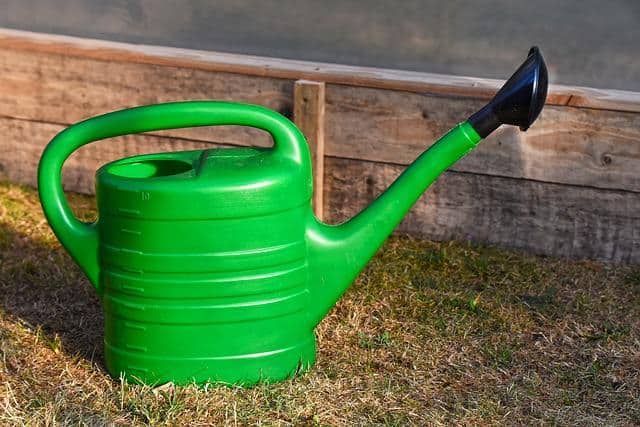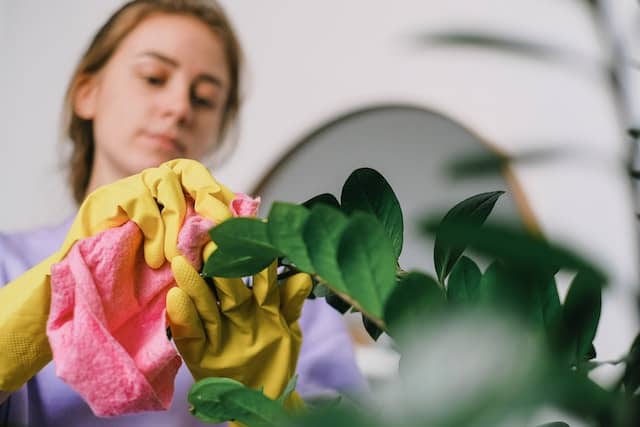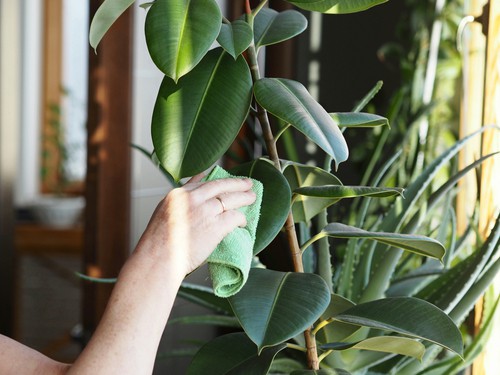In search on how to save a dying rubber tree plant? A rubber tree (Ficus elastica) or rubber plant (Ficus elastica) is a large indoor house plant with waxy leaves. Originally from Southeast Asia, rubber tree plants reach up to 100 feet.
The maximum height of a domesticated house plant is ten feet. If grown outdoors, rubber plants are also quite successful. Their leaves are rubbery and shiny. Their sap can be used to make rubber, earning them the rubber plant.
Although rubber plants are among the easiest houseplants to maintain due to their insensitivity to the environment and hardiness, you might find your plant leaves turning yellow, leaves falling off, and a struggling plant if you fail to adhere to its care tips.
Caring for your rubber tree plant includes maintaining the proper lighting, watering, and temperature levels, as well as addressing any pest or disease issues promptly to keep your plant healthy and thriving.
So first, it’s vital to watch out for these and other warning signs and treat them promptly to prevent your rubber tree from dying. Keep reading this article to learn how to save a dying rubber tree plant.
How To Save A Dying Rubber Tree Plant?

Rubber plants aren’t difficult to maintain. A little balance is all it takes. Your plant will remain healthy, strong, tall, and happy if it receives sufficient sunlight and water. Rubber plants shrink and darken when they need more water and sunlight. When you notice droopy leaves, give the plant water and put it in the sun.
The rubber plant is an indoor plant that is hardy by nature. However, they may die or start dying occasionally. The leaves will turn yellow or black spots will appear on the leaves, the soil will smell foul, leaves will fall off, and many more instances will occur.
Can anything be done? Is there any way to save your rubber plant? Find out how!
Leaf drooping is typically caused by excessive watering. The conditions may also include insufficient light, poor soil health, temperature fluctuations, or diseases. An unpleasant smell may be caused by root rot. Find the cause of the problem and fix it as soon as possible to save your rubber plant.
Dying Rubber Plants: Signs And Symptoms
It is possible to tell if a rubber plant is dying by seeing signs.
Brown or yellow leaves
When the leaves of a rubber plant become dry or moist, they turn brown and yellow. A plant’s leaves become yellow if too much water is applied to them, and the leaves lose their color when there is less water applied.
There are spots on the leaves of the rubber plant.
The stage when you need to take excellent care of your plant is when you will see leaf blight or spots on leaves. In this case, the leaf blight indicates fungus on the leaves, eventually harming the plant.
Rubber Tree Plants That Are Dying: How To Save Them
Proper Watering:

You should stop watering if your plant is overwatered and make sure there are no dead leaves. Ensure that dead leaves are trimmed. Plants growing in rubber need to be watered more often than bigger plants. They need to be soaked four to five times a week. They can survive for seven days without water.
Moisture Must Be Maintained:
Water your plants regularly and keep the soil moist so that your plants thrive and drain properly. It is not necessary to water the plant more than one inch deep. Misting your plants during dry weather will ensure adequate drainage.
A Guide To Caring For Rubber Plants
However, rubber plants do not require much supervision and are easy to grow. By taking some precautions, you can prevent your plant from dying suddenly.
Following these steps will help you take good care of your rubber plant and increase its growth.
- You can make your rubber plant a happy, strong, and tall plant by providing it with the right amount of light. Do not expose your rubber plant to direct sunlight.
- Maintain a moist soil environment. A damp cloth can help your leaves absorb more sunlight by moistening them. You will need to provide more water to your rubber plants during the summer.
- The ideal temperature range for rubber plants is 60°F to 75°F, but they can also survive at 50°F. Rubber plants can also survive in less humid environments.
- In addition, you can change your plant’s pot if it is not growing, which provides additional support. As your rubber plant requires a suitable pot, you will need to change your pot every year.
- Choose soil with a sound drainage system that holds moisture and dries quickly.
Rubber Plants Have Many Advantages.
It is beneficial to have a rubber plant.
A Low Level Of Maintenance
It proliferates and doesn’t require much care and attention. There is no need for fertilization if it grows in moist soil and low light. Supplemental feeding is not needed for the rubber plant.
It Does Not Cause Allergies
Rubber plants do not produce pollen like indoor plants, so they do not cause allergies.
Leaves Can Be Easily Cleaned

It is easy to clean the rubber plant because of its waxy leaves, which are slippery to touch.
Removing Pollutants From The Air
As a result, the rubber plant removes formaldehyde from the air and also reduces carbon dioxide and carbon monoxide from our environment.
Also read: How To Plant Succulents In Glass Containers?
Summary
Now, you know how to save a dying rubber tree plant? Now, you have the answer to the questRubber plants are among the best indoor plants because they improve the air by absorbing pollutants and give off a healthy vibe.
In addition to gifting a rubber plant to your friends and relatives, you can also use it as a decoration. Therefore, if you want an indoor plant, you should go for a rubber plant.
Frequently Asked Questions
How do I know if my rubber plant is dying?
Don’t worry about a few leaves dying as long as the rest of the plant is healthy and new leaves are growing (like there are on this one). If there are more leaves on the plant or more substantial growth, the Rubber Plant will drown.
Is It Possible To Bring A Rubber Plant Back To Life?
Once you have determined that your rubber tree plant has too much water, it is time to revive it. If it gets too much water, stop watering it immediately and allow the soil to dry. After the soil has dried to a depth of 1 inch, stop watering the plant. In the event of root rot, remove the plant from its soil and pot.
The leaves of my rubber plant are falling off. Why is this happening?
Rubber plants commonly lose leaves when the light changes. Higher humidity is required for rubber tree plants. Rubber tree leaves can drop because of the lack of moisture. Winter can dry for houses, especially when the heat is on.

Hey, I’m Lisa and I’ve been an avid gardener for over 30 years. I love writing, talking and living in the garden! Feel free to connect with me on my socials below


